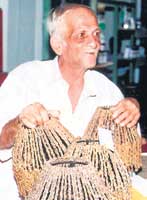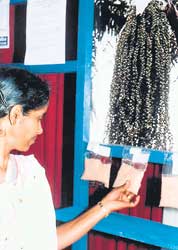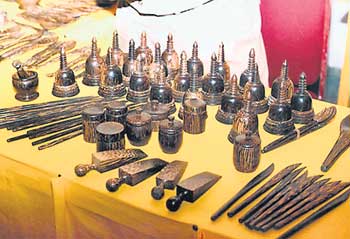
| The various uses of the Kitul tree The ‘Kitul’ tree or the botanical name - Caroyta Urens - was at one time a small time tree freely used by villagers to manufacture treacle or toddy. In fact a time came when one had to seek a permit from government agencies to collect the sap from this tree. The reason was that it was mainly used to manufacture toddy at village level. It was definitely better than the now produced 'Kassippu '.
In certain areas of the country it was a discarded tree standing in the Kandyan home garden often felled for used for elephants during Perahera time. However it has taken a complete turn now and assumed a unique place in the economy of the Central Province or elsewhere where the plant grows.
Kitul grows on ranges of 5000 feet and above in places like the Himalayas, Nepal, Assam, India and Sri Lanka. There was time in the ancient Kandyan days, when the ‘Kitul’ tree had a place in society where the sap was used as a fermented drink and also as treacle and juggery. However, with the gradual increase in the standard of education, the tapper of the ‘Kitul’ tree waned away and there were no tappers for this task. So the ‘Kitul’ tree except in areas like Kotmale, stood as a tree with others in the Kandyan home garden. However with the passage of time, the ‘Kitul’ tree has again come into importance, with new trends of tapping. Universities and other agencies have taken an interest and developed a method known as the ‘Kasper’ system, which gave an impetus to the ‘Kitul’ tree and also scope for tappers to turn professional. However the stage of marketing their products is still a problem because they need to find a market. Those who were lucky sell their products in at tourist resorts. Ms S. Chandrasekera, a producer from Teldeniya marketing her products under the brand of ‘Rasahala' has come up with a unique idea of producing treacle in five rupee sachets. This is only meant for the yoghurt trade. This packet which contains treacle is just fit enough for the yoghurt cup. It was pointed out by others, that if one has to use a treacle bottle, the amount that would be placed in the yoghurt cup would vary and sometimes, the customer asks for more. The sachet produced by Chandrasekera is just the right amount for the cup and she has a number of customers.
Support for such producers has come from the Sri Lanka – German Economic Strategy Sport Programme (ESSCP). The main task of this enterprise is to bring the manufacturer, the product, the seller, buyer and also the export people together. The ESSP is to launch a mechanism to remove the ‘selling’ bottlenecks and help in the marking of products with quality. ESSP conducted an exhibition cum promotion campaign at Queen's Hotel in Kandy, with stalls displaying high quality ‘Kitul’ products of individuals and companies This was the first time that the ‘Kitul’ producer came into direct contact with the buyer and the wholesaler for export purposes. The question raised was whether the producer has the resources to produce enough to meet the needs of the exporter. The Kandy Times spoke to H.M. Hamine of Kotmale, who has been producing treacle and juggery ever since she knew how to produce it. She said that the 'sap' of the ‘Kitul’ flower would be available within two hours to produce quality treacle or juggery. She said that that if she had a small vehicle or a trishaw, she could collect more ‘sap’ and produce more because of the demand. From seven to eight bottles of 'sap’ only one bottle of treacle could be produced while 11-12 bottles of 'sap' are needed to produce a pound of juggery. Six to seven bottles of ' sap’ is used to produce one bottle of fermented toddy. |
| || Front
Page | News
| Editorial
| Columns
| Sports
| Plus
| Financial
Times | International
| Mirror
| TV
Times | Funday
Times | Kandy
Times || |
| |
Copyright
2006 Wijeya
Newspapers Ltd.Colombo. Sri Lanka. |


